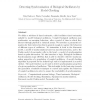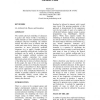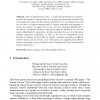372 search results - page 27 / 75 » Using heart rate to control an interactive game |
TCS
2010
13 years 7 months ago
2010
We define a subclass of timed automata, called oscillator timed automata, suitable to model biological oscillators. Coupled biological oscillators may synchronise, as emerging be...
TOG
2002
13 years 8 months ago
2002
This paper presents a framework for the skeleton-driven animation of elastically deformable characters. A character is embedded in a coarse volumetric control lattice, which provi...
GAMEON
2000
13 years 10 months ago
2000
The realistic physical modelling of characters in games and virtual worlds is becoming a viable alternative to more traditional animation techniques. Physical modelling can enhanc...
FUNGAMES
2010
13 years 9 months ago
2010
Recent work in neuroscience suggests that there is a common coding in the brain between perception, imagination and execution of movement. Further, this common coding is considere...
EDUTAINMENT
2009
Springer
14 years 3 months ago
2009
Springer
Acts of interpersonal touch – a touch shared between two people – are used by couples to communicate in a simple and emotionally intimate way. In this paper, we argue that the ...



